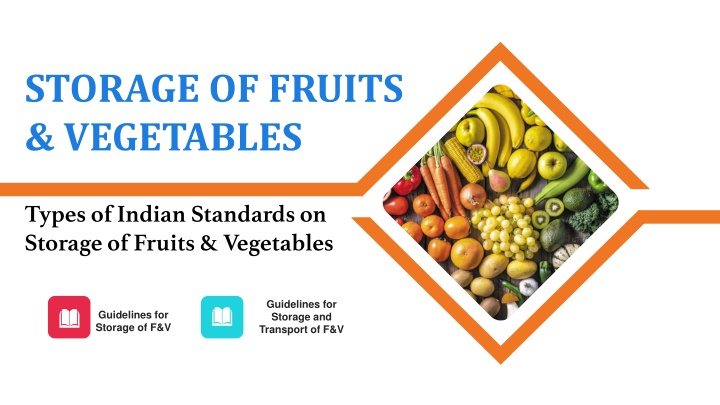
Effective Storage and Guidelines for Fruits and Vegetables
Discover Indian standards for the storage of fruits and vegetables, including techniques such as refrigeration and controlled atmosphere storage. Learn about recommended storage temperatures and lifespans for various produce like green bananas, grapes, and mangoes. Explore the proper conditions and procedures for the storage and ripening of mangoes according to IS 9304:2022. Ensure optimal fruit quality through detailed pre-storage operations.
Download Presentation

Please find below an Image/Link to download the presentation.
The content on the website is provided AS IS for your information and personal use only. It may not be sold, licensed, or shared on other websites without obtaining consent from the author. If you encounter any issues during the download, it is possible that the publisher has removed the file from their server.
You are allowed to download the files provided on this website for personal or commercial use, subject to the condition that they are used lawfully. All files are the property of their respective owners.
The content on the website is provided AS IS for your information and personal use only. It may not be sold, licensed, or shared on other websites without obtaining consent from the author.
E N D
Presentation Transcript
STORAGE OF FRUITS & VEGETABLES Types of Indian Standards on Storage of Fruits & Vegetables Guidelines for Storage and Transport of F&V Guidelines for Storage of F&V
METHODS OF F&V STORAGE REFRIGERATION Cold storage facilities to maintain low temperatures so as to slow ripening and decay CONTROLLED ATMOSPHERE Modifying gas composition (e.g., high CO2, low O2) to extend storage life of fruits & vegetables
RECOMMENDED STORAGE TEMPERATURE & STORAGE LIFE GREEN BANANAS TABLE GRAPES MANDARINS MOSSAMBI GRAPEFRUITS Short Term Storage Temperature: 15 to 18 Long Term Storage Temperature: 5 to 7 Short Term Storage Temperature: 15 to 18 Storage Temperature: 25 to 30o C Storage Temperature: 0 to 1o C Storage Life: 12 to 14 Weeks Storage Life: 3 Weeks Long Term Storage Temperature: 15 to 18 Storage Life: 12 Weeks Storage Life: 3 Weeks Long Term Storage Temperature: 5 to 7 Storage Life: Less than 1 Week Storage Temperature: 10 to 15 Storage Life: 4 to 12 Weeks Storage Life: 12 to 16 Weeks Storage Life: 3 to 6 Weeks
IS 9304:2022 - STORAGE AND RIPENING OF MANGOES Mango (Mangifera indica L.) is the native of Indo-Burma region and innumerable varieties of mangoes are cultivated. It is a seasonal crop and is highly perishable. Fruits picked at proper stage of maturity can be kept in fresh state for a few days only, under normal conditions. Therefore, fruits should be preserved under proper conditions so as to prolong their life for fresh consumption and processing.
IS 9304:2022 - STORAGE AND RIPENING OF MANGOES Conditions for harvesting and putting into storage Maturity Maximum fruit quality is attained when the fruits are harvested at optimum stage of maturity as immature fruits develop into inferior quality after ripening. Mangoes should be harvested at mature green stage, which can be judged by fully developed cheeks with outgrown shoulders and prominent pit at the stalk end; Change in skin colour from dark-green to light-green; Visibility of lenticels; spurt of sap exudation from the cut end of stalk is very less; Change in flesh colour from white to yellowish; and specific gravity is more than 1.0 (Alphonso, Kesar, Langra, Raspuri).
IS 9304:2022 - STORAGE AND RIPENING OF MANGOES Conditions for harvesting and putting into storage Pre-storage Operations - Sorting, de-sapping, washing, hot water treatment before storage are detailed in the standard. Quarantine Treatments - Different countries demand different disinfestation treatments against mango fruit fly and or stone weevil as a quarantine treatment for export purpose. a) Mangoes should be treated in hot water at 48 C for one hour as a disinfestations treatment against fruit fly. After hot water treatment the fruits should be cool rapidly and surface dried before packing.
IS 9304:2022 - STORAGE AND RIPENING OF MANGOES Conditions for harvesting and putting into storage Quarantine Treatments For control of quarantine pests (fruit fly), Vapor Heat Treatment (VHT) system that uses heat saturated water vapour is used. During VHT treatment fruit pulp core temperature is maintained at 47.5 C for a minimum of 20 min. Mangoes may be irradiated with a D min. of 400 Grays at the approved and certified irradiation treatment facility. Irradiation treatment is approved for control of both fruit fly and seed/stone weevil infestation. The radiation dose used are within the window of approved dose range for Fresh Fruits and Vegetables as per regulations
IS 9304:2022 - STORAGE AND RIPENING OF MANGOES Storage The fruits should be packed properly before putting into storage rooms. Fruits can be placed in ventilated plastic crates of 20-25 kg capacity or in 5 ply corrugated fiberboard (CFB) boxes. At ambient temperature the storage life of mangoes is limited to 7-12 days depending on the variety and maturity. However, at an optimum temperature of 13 C and 85-95 percent relative humidity, mango can be stored for about 20-25 days.
IS 9304:2022 - STORAGE AND RIPENING OF MANGOES Pre-cooling Mangoes are harvested during summer season with more field heat, it is advisable to pre-cool them faster before putting into cold rooms. Pre-cooling is usually done by more efficient forced air cooling method. Mangoes should be pre cooled to 13 C (the recommended storage temperature) by placing the fruits in pre-cooler room where temperature is set at 13 C with 90 to 95 percent RH.
IS 9304:2022 - STORAGE AND RIPENING OF MANGOES Optimum Storage Conditions After precooling the fruits should be immediately shifted to cold rooms set at 13 C and 85- 95 percent RH. At storage temperature below 13 C, mangoes are susceptible to chilling injury that cause discoloration of the skin, pitting and uneven ripening when shifted to ambient conditions with increase susceptibility to decay. At optimum temperature mangoes can be stored up to 3 weeks. The crates or boxes should be staked and arranged in the cold room in a manner so as to permit free circulation of air. The storage density between 200 and 250 kg per cubic meter of usable space is considered suitable.
IS 9304:2022 - STORAGE AND RIPENING OF MANGOES RIPENING Permitted Artificial Ripening Ethylene in the form of gas can be sourced from commercial ethylene gas cylinders or small canisters or produced by ethylene generators. Mangoes should be exposed to the ethylene gas in air-tight chamber/plastic tent for 24 h with the concentration of the gas about 100 ppm Natural Ripening Mature mangoes are ripened naturally by covering the heap with paddy straw or by individually wrapping the fruits with newspaper. Ethylene gas is released from the fruits in due course of time that helps in ripening of fruits. Natural ripening of mangoes is a bit slow leading to high weight loss, shrivelling and in some cases uneven ripening
IS 9311 : 2021 GUIDE TO STORAGE OF ONIONS Provides recommendations for the storage, with or without the use of artificial refrigeration, of onions intended for long term conservation and consumption in the fresh state prescribing conditions of harvesting and putting into store which include quality characteristics, various treatments before storage and methods of storage.
IS 9311 : 2021 GUIDE TO STORAGE OF ONIONS Cultivars Choose onions cultivars suitable for long storage. Varieties having medium bulb size with: higher dry matter/total soluble solids content, higher pungency, less or no splits and thinner necks with retention of higher number of dry outer scales have better keeping quality with lower storage losses.
IS 9311 : 2021 GUIDE TO STORAGE OF ONIONS Harvesting As onions mature, their dry matter content and pungency increase, with a resulting increase in storage potential. Onion bulbs should be harvested one week after 50 percent of plants have shown neck fall. By this time the bulbs are covered with well-differentiated outer scales signifying that they are in a state of physiological rest. Early harvesting would result in more sprouting during storage. Whereas delayed harvesting may result in reduction of skin quality, increased rooting and reduction in firmness. Harvesting of onions should be carried out when the weather is dry; harvesting after a rainfall, or when the humidity is high increases susceptibility to post-harvest disease.
IS 9311 : 2021 GUIDE TO STORAGE OF ONIONS Irradiation Post-harvest treatment with gamma irradiation is successful in reducing storage losses The application of low doses of radiation can arrest sprouting of onions during storage Application of irradiation of the order of 60 Gy to 100 Gy for control of sprouting and extension of shelf life of onion is recommended The irradiated onion bulbs are reported to be superior in quality with respect to internal and external appearance and firmness after 180 days storage than non-irradiated ones
IS 9311 : 2021 GUIDE TO STORAGE OF ONIONS Storage The onions may be stored in bulk, in packages on pallets, in box pallets, in crates, in sacks or in containers. Onions packed in sacks may be stored for only a short period of time. In the case of storage in bulk, the maximum depth to which onion can be heaped is between 0.9 to 1.5 meters. Higher depth of bulk storage causes excessive damage from pressure impact/bruising. Onion should not be dropped on ground from higher than 1 to 2 meters which would damage the bulbs. In case of packed onions, to avoid damage, packages should be stacked 5 to 7 tiers high, and a gap of 15 cm to 20 cm in the proximity of the side walls and 5 cm to 8 cm between the stacks of packages should be provided to ensure the free circulation of air.
IS 9311 : 2021 GUIDE TO STORAGE OF ONIONS Storage For long term storage of onions, proper ventilation, optimum temperature and humidity are of paramount importance. Absence of proper aeration/ventilation, high atmospheric humidity (75-80 percent RH) promotes development of pathogen/rotting, and promotes root growth. Low humidity (less than 65% RH) leads to excessive moisture loss from bulbs, resulting in shriveling and loss in weight.
GUIDELINES FOR STORAGE OF F&V IS No. Title IS 6669: 2001/ ISO 1212:1995 Apples - Guide to cold storage IS 6670: 2018 IS 7192: 2022 IS 7730: 2022 IS 7731: 2021 IS 9303: 2021 IS 9304: 2022 IS 9311: 2021 Storage of potatoes - Guidelines Citrus fruits - Guidelines for storage Guide for storage of pears Guide for storage of peaches Guide for cold storage of table grapes Guide for storage and ripening of mangoes Guide to storage of onions
GUIDELINES FOR STORAGE OF F&V IS No. Title IS 11965: 2022 IS 11966: 1997/ ISO 6663:1995 IS 16118: 2013/ ISO 6665 : 1983 IS 16119:2013/ ISO 7562 : 1990 IS 16120:2013/ ISO 5525: 1986 Guide for storage of round headed cabbage Garlic - Cold storage Strawberries - Guide to cold storage Potatoes - Guidelines for storage in artificially ventilated stores Potatoes - Storage in the open (In Clamps)
GUIDELINES FOR STORAGE & TRANSPORTATION OF F&V IS No. Title IS 7191: 2001/ ISO 5524:1991 IS 6028:2002/ ISO 931:1980 IS 15691: 2006 Tomatoes - Guide to cold storage and refrigerated transport Green bananas - Guide to storage and transport Guidelines for storage and transportation of bamboo shoot






















